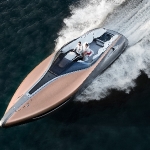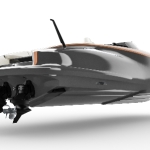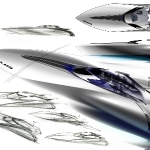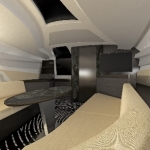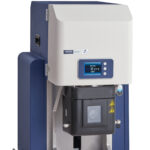A few years ago the Toyota Marine Department invited Toyota Motor Corporation president Akio Toyoda to spend several days on the water driving their new Ponam range of premium yachts soon to be launched in Japan. As a master driver, Toyoda was inspired by the power of the turbodiesel powertrains and the handling and stability of the advanced hull designs; as the Chief Branding Officer of Lexus International, he also appreciated the potential of a stylish premium performance yacht to complement the Lexus lifestyle. This led the Marine Department to envision how a premium performance yacht might expand the Lexus brand into new areas of lifestyle and recreation. Today Lexus reveals the result of this project, a running proof-of-concept for a Lexus Sport Yacht, at Di Lido Island on Biscayne Bay, Miami Beach FL.
Design
“This concept for a Lexus Sport Yacht allowed us to explore how Lexus design language could be applied to a maritime lifestyle,” said Yoshihiro Sawa, executive vice president of Lexus International. “For the Lexus Design Center this project has been very exciting. The effort is valuable to us as it stirs our creative energies and pushes our imagination to design and lifestyle possibilities outside of the automotive realm we know well.”
The selected proposal continued to be refined throughout 2015 as the Marine Department engineered the construction and onboard marine systems.
As a concept, the Lexus Sport Yacht revealed at Miami is a bespoke one-off project with no production intent. To produce this single example the Marine Department selected the Marquis-Carver Yacht Group of Pulaski, Wisconsin, USA, based on their in-house engineering and manufacturing capabilities and their skill in large hand-laid composite structures.
Features
The design of the Lexus Sport Yacht concept has the upper deck and outer hull seamlessly bonded around the inner structure, each piece a single massive hand-laid composite of two-part polyurethane epoxy resin reinforced with hand-laid woven carbon fiber cloth, a composite material called carbon-fiber reinforced plastic, or CFRP. CFRP is the technology used in the structure of racecars and supercars like the 202 miles per hour (325 kmh) 553 horsepower Lexus LFA, high-performance military and civilian aircraft, competition skis and bicycles, and worldclass racing sailboats. The Lexus Sport Yacht concept’s unique CFRP construction saves nearly 2,200 pounds (1,000 kg) compared to a similar yacht in fiberglass reinforced plastic (FRP). The underwater hull design is stepped to reduce resistance or drag and improve handling balance at high speeds.
The concept is powered by twin 5.0-liter V8 gasoline engines based on the 2UR-GSE high-performance engine of the Lexus RC F coupe, the GS F sport sedan and the new LC 500 grand tourer.



